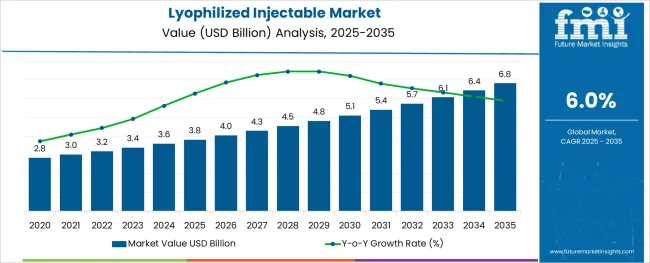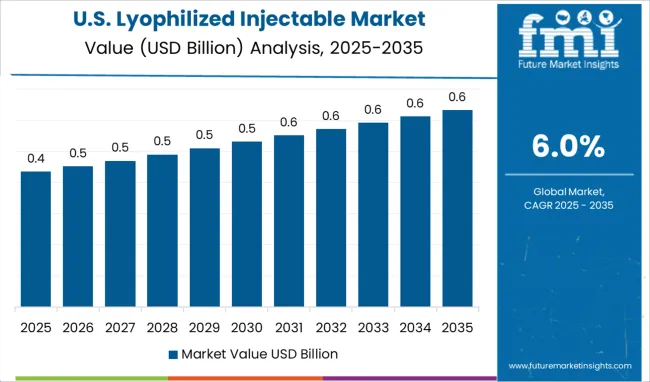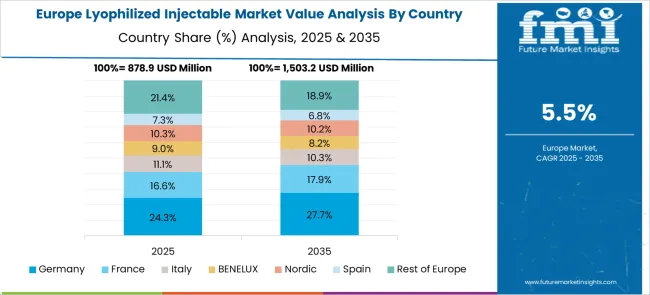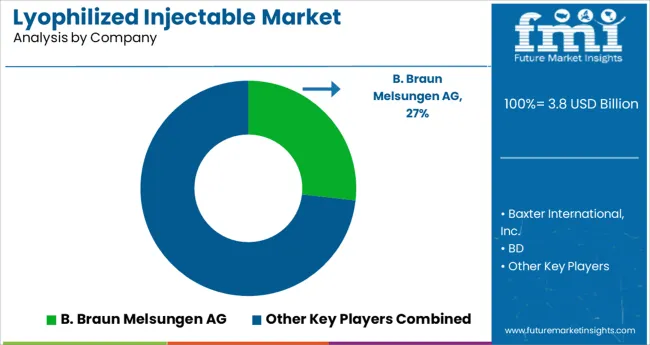The Lyophilized Injectable Market is estimated to be valued at USD 3.8 billion in 2025 and is projected to reach USD 6.8 billion by 2035, registering a compound annual growth rate (CAGR) of 6.0% over the forecast period.

The alginic acid market is undergoing consistent growth, propelled by rising demand from food processing, pharmaceutical formulations, and cosmetic applications. A growing focus on natural and sustainable ingredients in manufacturing processes has positioned alginic acid as a preferred biopolymer across industries.
The market is further supported by its diverse functional benefits, including water retention, gelling, and stabilizing properties, which make it indispensable in high-performance formulations. Increased regulatory acceptance of alginates as safe additives and the push towards cleaner labeling in food and personal care products have reinforced their adoption.
Ongoing innovation in extraction technologies and the utilization of algae as a renewable resource are paving the way for cost-effective production and expanded applications, ensuring sustained market expansion in the coming years.
The market is segmented by Packaging, Type of Delivery, Indication, and End User and region. By Packaging, the market is divided into Single-Use Vials, Point-of-Care Reconstitution, and Specialty Packaging. In terms of Type of Delivery, the market is classified into Prefilled Diluent Syringes, Single-Step Devices, Proprietary Reconstitution Devices, and Multi-Step Devices. Based on Indication, the market is segmented into Metabolic and Oncology Conditions, Infectious Diseases, Autoimmune Diseases, and Others.
By End User, the market is divided into Hospitals, Ambulatory Surgical Centers, Specialty Clinics, and Others. Regionally, the market is classified into North America, Latin America, Western Europe, Eastern Europe, Balkan & Baltic Countries, Russia & Belarus, Central Asia, East Asia, South Asia & Pacific, and the Middle East & Africa.
The market is segmented by Packaging, Type of Delivery, Indication, and End User and region. By Packaging, the market is divided into Single-Use Vials, Point-of-Care Reconstitution, and Specialty Packaging. In terms of Type of Delivery, the market is classified into Prefilled Diluent Syringes, Single-Step Devices, Proprietary Reconstitution Devices, and Multi-Step Devices. Based on Indication, the market is segmented into Metabolic and Oncology Conditions, Infectious Diseases, Autoimmune Diseases, and Others.
By End User, the market is divided into Hospitals, Ambulatory Surgical Centers, Specialty Clinics, and Others. Regionally, the market is classified into North America, Latin America, Western Europe, Eastern Europe, Balkan & Baltic Countries, Russia & Belarus, Central Asia, East Asia, South Asia & Pacific, and the Middle East & Africa.
When segmented by salts, sodium alginate is expected to command 27.5 % of the market revenue in 2025, marking it as the leading subsegment in this category. This leadership has been driven by its superior solubility, ease of incorporation into formulations, and versatility in a wide range of applications.
Its ability to form stable gels and maintain viscosity under varying conditions has made it highly sought after in both food and pharmaceutical sectors. Manufacturers have prioritized sodium alginate due to its consistent performance, cost-effectiveness, and regulatory acceptance, which have collectively strengthened its position.
The segment’s prominence has also been enhanced by its adaptability to evolving consumer preferences for plant-derived and sustainable ingredients, reinforcing its market share.
Segmented by end user industry, the food industry is projected to hold 33.0 % of the market revenue in 2025, positioning it as the most prominent sector. This dominance has been shaped by the industry’s increasing reliance on alginic acid and its derivatives to deliver desirable textures, stabilize emulsions, and improve shelf life of processed foods.
As consumer demand for clean label and natural additives has intensified, the food sector has responded by integrating alginates into bakery, dairy, and confectionery products. Enhanced production efficiency and compliance with food safety standards have further encouraged widespread use.
The segment’s leadership has also been supported by product differentiation strategies where alginates contribute to premium quality and innovation, securing their role in modern food formulations.
When analyzed by functionality, thickening agents are forecast to account for 29.0 % of the market revenue in 2025, establishing themselves as the dominant functional category. This preeminence has been underpinned by the growing need for consistent texture and viscosity in a wide array of end products.
Alginic acid’s natural origin and high efficiency in creating uniform, stable thickness without altering taste or color have solidified its appeal. The demand for thickeners in both edible and topical applications has expanded, with manufacturers leveraging its rheological properties to meet performance and regulatory requirements.
The functionality’s leading share has also been reinforced by the ability to deliver cost savings through lower dosages and its compatibility with other ingredients, securing its position as an indispensable component in formulation strategies.
Trials that are still going on are revealing added information about the safety and effectiveness of new lyophilized medicines that are being used to treat COVID-19. Manufacturers in the global lyophilized injectable market are getting licenses from the USA Food and Drug Administration (FDA) for the Emergency Use Authorization (EUA) of these products so they can treat people with severe COVID-19 symptoms.
Since the COVID-19 pandemic, companies that export lyophilized injectables have worked harder to obtain authorization from authorities like the Drug Controller General of India (DCGI) so that their goods may be used in India for limited emergency purposes. As more medications, like Remdesivir, get approved, the need for lyophilized injections will inevitably rise. The Food and Drug Administration (FDA) and other regulatory agencies have given their approvals for the following:
As a result, the expansion of the market for lyophilized injections is being driven by the rising number of approvals being granted all over the world.
There has been a significant increase in the number of businesses throughout the world using lyophilization technology because of the superior quality and longer shelf life of lyophilized medications. There has been a substantial uptick in the utilization of lyophilized injection pharmaceuticals by global contract research and manufacturing firms during the past few years.
The primary motivation for this change is to supply final consumers with better goods. Opportunities in the global lyophilized injectable market are being created by reasons such as the fast growth of Contract Research Manufacturing Services (CRAMS).
Due to their safety and capacity to fulfill their stated functions, lyophilized products have witnessed a substantial increase in usage recently compared to non-lyophilized ones. Besides this, the cold chain is not necessary for these items. Therefore, they contribute to lower carbon footprints and total expenses. As a result of these factors, the lyophilized injectable market is predicted to expand into new lucrative areas in the coming years.
The expansion of the sector for lyophilized injection drugs may be hampered by several incidents involving the recall of products containing complex medications. In recent years, there has been a significant increase in product recalls that have been reported by manufacturers. These recalls have been brought about by the presence of unwanted foreign substances or by adverse drug effects. Recalls have the potential to harm a company's reputation as well as its ability to generate revenue.
It is anticipated that the injection supplies pharmaceuticals market coming from the retail pharmacy segment is anticipated to hold more than 30 percent of the total industry share by 2035. As they provide convenient access, cheap rates, high-end customer care, and an extensive selection of items, retail pharmacies have emerged as one of the primary distribution channels. This is because retail pharmacies offer all these benefits.
In addition to this, pharmacies and other retail locations sell pharmaceuticals and offer individuals individualized guidance that caters to their specific healthcare issues and needs. In recent years, there has been a considerable increase in the number of retail pharmacies as well as pharmacy chains, which is indicative of a strong preference among customers for this type of distribution channel.
It is anticipated that the demand for lyophilized injectable medicines in the prefilled device category is likely to reach USD 6.8 Billion by 2035. Prefilled devices are becoming increasingly popular because of their ability to reduce the amount of time that patients are required to wait during hospital visits and to improve the level of medical care.
Along with ensuring the safe and convenient delivery of treatment, it also guarantees an elevated level of precision in the dosing of medications. Although the introduction of prefilled devices across a spectrum of drug classes and therapeutic categories can look quite different, it is anticipated that demand for the product is likely to remain steady.

The lyophilized Injectable market is estimated to grow profitably in North America in the upcoming years because of the rising frequency of disorders in the United States. The presence of significant manufacturers, like Fresenius Kabi and Merck & Co. Inc., and Amneal Pharmaceutical, both are involved in the production of lyophilized injections and helping to drive growth in the USA Lyophilized Injectable Market. Furthermore, the increasing number of product approvals made by regulatory authorities in North America is anticipated to be fueling the expansion of the USA Lyophilized Injectable Market.

It is expected that the size of the lyophilized injectable market in Europe is expected to exceed USD 6.8 Billion by 2035. This region is predicted to become a suitable region for the expansion of existing businesses due to the rising incidence of cancer and other ailments. Europe, which has one of the oldest populations overall, is home to some of the world's oldest individuals.
The growth of the senior population, which has a compromised immunological and metabolic system and is consequently at a higher risk of developing life-threatening illnesses, is another significant factor that is projected to propel the sector. According to several studies, the native populations of Belgium, the Netherlands, Denmark, and Ireland have the greatest incidence of cancer patients compared to that of any other European nation.
The coronavirus has grown to pose a significant threat to public health because it causes such severe respiratory symptoms and is ever-evolving. Adult hospitalized patients with COVID-19 are the focus of ongoing research on the efficacy and safety of novel lyophilized treatment medicines. Within this context, Cipla, a worldwide pharmaceutical business, is getting attention for releasing CIPREMI, a remdesivir lyophilized powder for injection (100 mg).
Manufacturers in the lyophilized injectable market are adopting cues from these developments to enhance access to the Emergency Use Authorization (EUA) medication approved by the USA Food and Drug Administration for people experiencing severe COVID-19 symptoms.
With the third wave of the pandemic hitting India, manufacturers in the lyophilized injections industry there are stepping up their efforts to secure regulatory permission from the Drug Controller General of India (DCGI) for limited emergency use in the country.

Major players catering to the global demand for lyophilized injectables are showing a rising interest in the creation of drug delivery systems that are universal, upgradeable, and configurable. To do this, they are putting a significant amount of money into research and development-related operations.
A trend toward the incorporation of electronic components into injectors and other types of devices is likely to emerge among industry participants in the years to come. It is anticipated that these capabilities are expected to permit modification as per the user type that is proposed. Soon, it's anticipated that these devices' networking capabilities will allow for remote upgrades. As of this element, the process of managing the lifecycle of these devices is anticipated to become less difficult.
Key players in this industry rely on a strategy of continuous product development and improvement to meet the needs of their clients throughout the world and maintain their reputation in the cutthroat global lyophilized injectable market.
In April of 2025, for instance, Recipharm purchased both the advanced therapy CDMO (Contract Development and Manufacturing Organization) Arranta Bio and the virotherapy CDMO Vibalogics. As a result of the purchase, Recipharm now has a sturdy foundation in the USA owing to its new Boxborough, Massachusetts facilities, and a solid foundation upon which to expand its capabilities into other biologics modalities.
The global lyophilized injectable market is estimated to be valued at USD 3.8 billion in 2025.
It is projected to reach USD 6.8 billion by 2035.
The market is expected to grow at a 6.0% CAGR between 2025 and 2035.
The key product types are single-use vials, point-of-care reconstitution and specialty packaging.
prefilled diluent syringes segment is expected to dominate with a 42.9% industry share in 2025.






Full Research Suite comprises of:
Market outlook & trends analysis
Interviews & case studies
Strategic recommendations
Vendor profiles & capabilities analysis
5-year forecasts
8 regions and 60+ country-level data splits
Market segment data splits
12 months of continuous data updates
DELIVERED AS:
PDF EXCEL ONLINE
Injectable Osteoarthritis Microspheres Market Size and Share Forecast Outlook 2025 to 2035
Injectable Drug Industry Analysis in North America Forecast Outlook 2025 to 2035
Injectable Anti-Wrinkle Treatment Market Size and Share Forecast Outlook 2025 to 2035
Injectable Thyroid Drug Market Size and Share Forecast Outlook 2025 to 2035
Injectable Nanomedicines Market Size and Share Forecast Outlook 2025 to 2035
Injectable Liquid Filling Machines Market Size and Share Forecast Outlook 2025 to 2035
Injectable Drug Market Analysis - Size, Share, and Forecast Outlook 2025 to 2035
Injectable Potassium Phosphate Market – Growth & Forecast 2024 to 2034
Injectable Drug Delivery Market Analysis – Growth & Trends 2024-2034
Injectable Cocoa Fillings Market
Injectable Drug Packaging Market
Injectable Benzodiazepine Market – Trends, Growth & Forecast 2022-2032
Injectable Bulking Agents Market
Global Non-injectable Insulin Market Insights – Size, Trends & Forecast 2024-2034
Lipid Injectable Market
Spinal Injectable Market Size and Share Forecast Outlook 2025 to 2035
Generic Injectable Market Report - Growth, Demand & Forecast 2025 to 2035
Global Sterile Injectable CDMO Market Analysis – Size, Share & Forecast 2024-2034
Glucagon Injectable Market
Ophthalmic Injectable Market Size and Share Forecast Outlook 2025 to 2035

Thank you!
You will receive an email from our Business Development Manager. Please be sure to check your SPAM/JUNK folder too.
Chat With
MaRIA